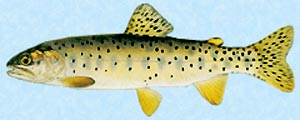Watershed Reservoirs Aid in the Recovery of the Bonneville Cutthroat Trout
The state of Utah’s official fish is thriving in the streams and reservoirs in Dell Fork in Parley’s Canyon
LeRoy W. Hooton, Jr.
July 28, 2006
|
In a 2000 Conservation Agreement a goal was set to establish and maintain a minimum of 186 conservation populations inhabiting 1,593 miles of stream segments located in the cutthroat’s historic habitat in the western United States.
According to studies water diversions, habitat degradation, and the introduction of nonnative fish have reduced the cutthroat’s habitat to a mere 147 miles of stream segments in Utah. Two of those segments are located in Dell Fork of Parley’s Canyon located approximately 10 miles from Salt Lake City. The streams supplying Little Dell and Mt. Dell reservoirs are producing a healthy population of a pure strain of cutthroat, which now provides a brood source to plant in other streams and lakes along the Wasatch Front.
The recovery program in Dell Fork was kicked off on May 16, 1998 when Interior Secretary of Interior Bruce Babbitt visited the stream segment near AffleckPark to highlight Utah’s recovery program. Joined by representatives of the Utah Division of Wildlife Resources, Goshute Tribe, Utah Reclamation and Conservation Commission, Creek Mountain Ranch, Native Utah Cutthroat Association, U.S. Fish and Wildlife, The Utah Council of Trout Unlimited and Salt Lake City Department of Public Utilities, Secretary Babbitt touted the voluntary efforts of those in attendance to further the species. “The cutthroat was close to being listed as an endangered species, but this will not be necessary as long as efforts are underway to voluntarily recover the species,” said Secretary Babbitt.
With the filling of Little Dell Reservoir in 1992, the lake has bolstered the production of a robust population of cutthroat now weighting 3 to 4 pounds.
During the week of June 21, 2006 the Utah Division of Wildlife Resources caught spawning cutthroat in the two stream segments above each reservoir and stripped the females of their eggs. These eggs were fertilized onsite and in about 10 days the fingerlings will be hatched. During the next month these baby cutthroat will be planted in other stream and lakes along the Wasatch Front.
The successful propagation of the cutthroat is further enhanced under the protection of Salt Lake City’s watershed ordinances and restricted access to the two reservoirs. Little Dell Reservoir is managed as part of the Little Dell Recreation Project by Department of Public Utilities Watershed Officers. Fishing is allowed, but it is catch and release only. There is no fishing allowed in Mt. Dell Reservoir and access is prohibited and trespassing laws are enforced by the Salt Lake County Sheriff Department.
Besides providing additional water supply and flood control benefits, the construction of Little Dell Project along with Mt.Dell, has provided a perfect habitat for the cutthroat trout. According to a KSL television newscast interview aired on June 22, Utah Division of Wildlife outreach officer Scott Root said that the cutthroats in the two reservoirs are large, and it’s a perfect setting for the recovery program.
